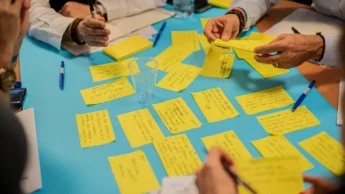‘Customer-centric change is 10% inspiration and 90% perspiration’. A quote that we think is absolutely right. Because how do you make sure that you, as a company, start innovating in a way that will make your customers happy? Customer-centric innovation, how do you go about it?
For example:
Harry is a product manager at a producer of gas fireplaces. Because the government strives for a climate-neutral society, a lot is coming to Harry and his colleagues. How does the company maintain a good market position? And how do you ensure that all employees keep their jobs in a changing market? For Harry it is absolutely clear: innovation is the solution.
Harry has already been through quite a search. He explored the technical possibilities and the associated points for attention. It soon became clear to him that a lot is possible. But does the customer want that too? What are the real needs of the market?
In this blog we dwell on customer-centric innovation. We follow Harry in his quest for customer-centric innovation. He does so by means of the following paragraphs:
- Sparring with the customer
- D-day
- Ifs and buts
- Tip 1: change the way of thinking
- Tip 2: find an ambassador
- Innovation is learning and doing
Are you also interested in turning your idea into reality? We are happy to assist you. Feel free to drink a cup of coffee with us to discuss the possibilities.
Sparring with the customer
Anja is Harry’s contact person at his main dealer. Together they organize a discussion with a number of customers. Pretty exciting. Because what are they going to say? What are they excited about? And can Harry and his team live up to those options? Do they come up with good arguments? And can Harry make promises or does he create endless expectations?
D-day
It’s time. Harry is ready. The flipchart and the markers too. The customer panel talks to each other and Harry and the options and suggestions are fly around the room. Harry records them all. Everyone is happy at the end of the afternoon. Harry with the input and the panel because their opinions and suggestions are taken seriously.
The conclusions of that afternoon? The customer panel especially values atmosphere and convenience. Hence, the app is still an interesting option. Especially if it provides a better insight into consumption and makes it possible to vary the mode. Or if he reports what exactly is going on in the event of a malfunction or which part needs to be replaced. Such an app makes the gas fireplace a more complete product that meets the wishes of the customer.

Ifs and buts
Fortunately, there are also critical notes, because they offer the opportunity to improve (even further). The customer panel wonders what will happen if the Netherlands gets rid of natural gas. What’s the point of their old gas fire? Is it easy to convert to a fire that uses a different fuel? What guarantees do they get? Or will they be given the option of an add-on or the option of swapping out the burners for a different type by then? Harry must not answer them at that point. He needs to think about it for a moment, because it is about much more than “simply” revising the business model. But he will definitely come back to it in the future.
Relieved and happy, Harry comes home. He is looking forward to taking the next steps. And to spar with his friend Johan, whom he sees tonight. He is independent, looks at everything from the other side (sometimes annoying, but now very useful) and occasionally has brilliant ideas.
Tip 1: Change the way of thinking
While they are having a beer that evening, Johan tells about a beautiful documentary he saw recently. It was about an investigation in the Second World War. The aim of the study was to improve the survivability of fighter aircraft by analyzing the damage after a flight. The researchers made a list of the defects found and the points that needed to be strengthened. Until one of the researchers commented that they were now investigating planes that had returned. The planes that had not returned had probably hit other points. Chances were that the list of points that needed strengthening was not entirely correct. A nice insight.
This makes Harry think. He has now spoken to customers who bought their product, who were enthusiastic and would likely return as a customer. But it would be good to also ask people who had requested a quote, but who had not bought a fireplace. What was their motivation for not buying? And how can they respond to this as producer and seller?
Tip 2: Find an ambassador
Harry’s musings are interrupted by Johan’s following suggestion. “Find someone within management who subscribes to your idea and believes in it. Then you have an ally who supports your story, who also feels responsible for the plans and who helps you further. In other words, someone who represents you in the boardroom. “
That seems like something to Harry. He decides to present the results of the search to the technical director tomorrow. The common thread of his story is that the company will add extra value to the gas fireplaces with digitization. It is technically possible. And Jan (head of engineering), Peter (head of marketing), Anja (contact person at the dealer) and the customer panel are already enthusiastic. He is simply going to transfer that collective enthusiasm to the technical director. You would say, what could go wrong?
But more about that next time.
Innovation is learning and doing
Just like Harry, you will encounter more and more questions when looking for an innovative solution. You look at various options, you research and inventory and you learn from the insights you encounter on your path. And then you do it, because of course it does not stop at thinking.
Engaging Beeliners for your innovation
Would you like to have your idea worked out in cooperation with Beeliners? We would love to help you! Feel free to drop by for a cup of coffee and we will be happy to discuss the possibilities with you.
Also interesting
-

What is market research and how do you approach it?
When you’re preparing to launch a new product, it’s natural to be excited about your idea. But does the market share your enthusiasm? How do others view your idea? Or could it be that your new idea already exists? Market research helps you answer these questions. This type of research… Read More
-

The iterative process: why and how we apply it
Every morning you wake up and the first thing you do is check your mobile phone. Throughout the day, you receive messages on it, and before you go to sleep at night, you set your alarm. We can no longer imagine modern phones not existing. In fact, the very first… Read More
-

7 tips for organising an innovation workshop with your team
An innovation workshop is an interactive session designed to help participants generate new ideas, come up with creative solutions and develop innovative processes. During an innovation workshop, participants can collaborate and brainstorm to discover new perspectives and solve existing problems. Innovation workshops can be organised for various purposes, such as… Read More

